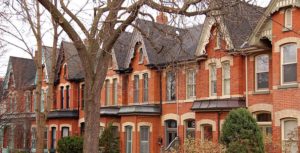 The initial residential development in the Cabbagetown area started in the 1850s. Significant housing development began in the 1870s and 1880s. Most of the houses built in that period are still visible in the District today. Development would continue to the beginning of the twentieth century, establishing the late Victorian character in the neighbourhood. Individual buildings of more varied early twentieth century architectural influences were built between 1900 and the First World War. St. Enoch’s Church (1891) and the Hampton Mansions Apartment built at Metcalfe Street and Winchester Street (1910), across the street from each other, represents the largest buildings in the District.
The initial residential development in the Cabbagetown area started in the 1850s. Significant housing development began in the 1870s and 1880s. Most of the houses built in that period are still visible in the District today. Development would continue to the beginning of the twentieth century, establishing the late Victorian character in the neighbourhood. Individual buildings of more varied early twentieth century architectural influences were built between 1900 and the First World War. St. Enoch’s Church (1891) and the Hampton Mansions Apartment built at Metcalfe Street and Winchester Street (1910), across the street from each other, represents the largest buildings in the District.
By the early twentieth century the population of Cabbagetown included labourers, employed in local businesses and industries, and a more prosperous people who lived in the larger residences. Occupations and income groups varied. The mix of occupations of early residents range from store managers and carpenters to businessmen, accountants, clerks, doctors, salespersons, cutters, church ministers, artists and butchers. The area also included business proprietors, nurses, messengers, brewery, gas and soap workers, stevedores and railway employees.
After the W.W.I the demographics changed, resulting in a decline in the condition of the building stock that lasted until the 1960s when a new generation of residents began to move into the District. By the 1970s urban renewal would play a significant role in the rebirth of older downtown neighbourhoods in Toronto. The Cabbagetown area participated in the renewal. It had the benefit of a “sense of place” derived from its past social conditions, land development history, pedestrian-oriented streetscapes and a defined architectural tradition.




